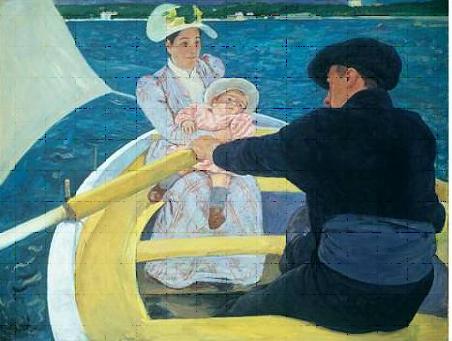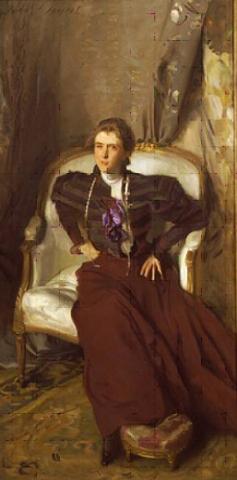Lesson Description
As the nineteenth century drew to a close, an ideal American “New Woman” appeared in art and literature. Independent-minded artist Mary Cassatt personified this New Woman, even though she often featured traditional domestic views of women in her paintings. John Singer Sargent’s portrait, Mrs. Charles Thursby, shows an intelligent, active New Woman. Charles Dana Gibson popularized the look of the New Woman in his Gibson Girl magazine illustrations. These educated women became part of the vanguard leading to women’s suffrage and passage of the Nineteenth Amendment, in 1920.
In this lesson, students compare Mary Cassatt’s traditional Madonnalike woman with Sargent’s and Gibson’s images of the 1890s New Woman. After reading a short worksheet description of the New Woman, students write a letter from the perspective of a New Woman. Students learn figure proportions as they sketch each other in activities that New Women engaged in. To assess their understanding, students create a magazine cover featuring a New Woman and a headline pertaining to the same time period.
Objectives
At the end of this lesson, students will be able to:
- Identify characteristics of the 1890s ideal New Woman.
- Explain how the New Woman differed from the ideal women of previous generations.
- Explain how the New Woman of the 1890s paved the way for future advances in women’s rights.
- Understand and describe how John Singer Sargent, Mary Cassatt, and Charles Dana Gibson depicted 1890s women.
- Draw a human figure using realistic human proportions.
Learning Standards
CCSS.ELA-Literacy.RH.11-12.7
CCSS.ELA-Literacy.WHST.11-12.1
CCSS.ELA-Literacy.RH.11-12.1
NAES - VisArts - 5-8, 4
NAES – VisArts – 5-8, 6
Lesson Activies
Activity: Look and Think
Lead students in a careful analysis of Mary Cassatt’s painting The Boating Party using the Teaching Activities in Picturing America Teachers Resource Book http://picturingamerica.neh.gov/downloads/pdfs/Resource_Guide_Chapters/P... to guide this analysis.
Show students John Singer Sargent’s portrait of Mrs. Charles Thursby.
Ask them what Sargent tells us, the viewers, about Alice Brisbane Thursby.
- What is the first thing you notice about her?
- How has Sargent emphasized this?
If students notice that she seems energetic and full of action, call attention to:
- Her pose—how she leans forward, sits on one side of the chair, her legs crossed, her hands on her hips.
- The many diagonals in her clothing and the whole composition that suggest action.
- Visible brushstrokes contribute energy to the painting.
If students notice her youthful face, note how Sargent emphasizes her face with:
- color that contrasts with the background.
- most of the background colors are muted warm tones surrounding lighter pinks in her face and the contrasting white of the chair and her collar.
- the central location of her face.
Encourage students to imagine what Mrs. Thursby might have done a few minutes after posing for her painting. Because she was well-educated, she might have read a book. This athletic young woman might have gone bicycle riding or painted a picture. Students may sketch each other in an activity that a New Woman might do.
Activity : Narrative Writing Based on Three Dimensional Image
Walk a mile in someone else’s shoes. Objects can tell us a lot about the people who use them. After a discussion on Mrs. Charles Thursby, students now understand how her clothing and poses identify her as a New Woman, pushing for more rights and seeking opportunities in the public sphere.
Teachers should show students the Newark Museum’s three-dimensional image of an 1890s woman’s shoes.
- Compare the shoes to the ones Mrs. Charles Thursby is wearing. How are they similar, and how are they different?
- Who could have worn these shoes?
- What could she have done in the public sphere?
- Was she married?
- Did she have an occupation?
- How old was she?
After formulating some ideas on who could have owned and worn these shoes, students will write a narrative diary entry from the perspective of the owner of these shoes.
Be sure to instruct students to add as much detail about the person as possible, including the above criteria.
Download full PDF lesson above to access Activity Worksheets
Activity: The Gibson Girl Magazine Cover Drawing
- Project or hand out an image of a Gibson Girl.
- Have students assess which painting, Mary Cassatt’s The Boating Party or John Singer Sargent’s Mrs. Charles Thursby, most suggests the 1890s concept of the New Woman. Explain why you think this. Give at least three reasons.
- Have students create a magazine cover featuring a Gibson Girl. Be sure to include a pose and surroundings.
- Charles Dana Gibson, “Scribner’s for June,” Scribner’s Magazine, June 1896.
Download full PDF lesson above to access Activity Worksheets
Extending the Lesson
-
Have students read and respond to the humorous but ironic introductory poem in Alice Duer Miller’s Are Women People? A Book Of Rhymes For Suffrage Times, 1915.
-
Encourage students to explore The Gibson Girl’s America, a Library of Congress online exhibition. http://myloc.gov/exhibitions/gibson-girls-america/Pages/default.aspx
Resources
The New Woman
During the last half of the nineteenth century, upper-class women became better educated than the women of previous generations. In 1838, the first women’s college, Mount Holyoke, opened in Massachusetts. Vassar opened in 1865, followed by Smith and Wellesley in 1875. By the 1890s, writers and artists were describing an ideal “New Woman” who was intellectually curious with an intense desire for education. This thinking woman developed individual interests and abilities that were not necessarily part of women’s traditional domestic roles. Artists depicted these women reading, riding bicycles, walking outdoors unaccompanied by males, and painting. Not everyone approved of this female model. Many critics thought women should devote their time and energies toward having children and raising families.
The Artists
Mary Cassatt and John Singer Sargent were Americans, but both spent most of their lives in Europe. Sargent was born in Florence, Italy, to American parents. Mary Cassatt lived in Europe as a small child and returned to France as a young woman. Both artists spoke French fluently and had families in Paris. Although Cassatt and Sargent were probably passing acquaintances, Cassatt was about twelve years older than Sargent and lived a quiet life with her family, while Sargent had many friends and traveled widely.

Mary Cassatt (1844–1926)
The Boating Party, 1893/1894
Oil on canvas, 35 7⁄16 x 46 1⁄8 in. (90 x 117.3 cm.)
Chester Dale Collection
Image © 2006 Board of Trustees, National Gallery of Art, Washington, D.C. 14a, Picturing America Teachers
Mary Cassatt was an independent New Woman. She studied art at the Pennsylvania Academy of the Fine Arts from 1860 to 1862 before moving to Paris in 1865. Although she studied with Jean-Léon Gérôme, a leading academic painter, as a woman she could not be admitted into the École des Beaux-Arts. Nevertheless, she exhibited her paintings in the Paris Salon. Her life changed when Degas introduced her to Impressionism. In 1877, she exhibited in the first Impressionist show. She devoted herself to her art, foregoing marriage and children. At that time, most women, even those who had jobs (which were few), put their careers on hold once they had children. Without electricity and modern conveniences, managing households was much more time-consuming than it is today. Deeply aware of what she had sacrificed for her career, Cassatt said, “There's only one thing in life for a woman; it's to be a mother. . . . A woman artist must be . . . capable of making primary sacrifices.”
Mary Cassatt often painted her sister Lydia, but when Lydia died in 1882, Mary was so sad that she did not paint as often as she had previously. She was also anxious about her parents’ health. But in 1889 she took up the theme of mother and child that continued to occupy her for the rest of her career. The pose of the middle-class woman holding her child in The Boating Party is reminiscent of medieval Madonna Enthroned altarpiece paintings. Learn more about the subjects in Mary Cassatt’s The Boating Party at Picturing America Teachers Resource Book, 14a
Learn more about Mary Cassatt at The Metropolitan Museum of Art, Mary Stevenson Cassatt (1844–1926)

John Singer Sargent (1856–1925)
Mrs. Charles Thursby, 1897–98
Oil on canvas
Newark Museum
Purchase by exchange 1985
Gift of Mr. and Mrs. Duncan Pitney, Emilie Coles from the J. Ackerman Coles Collection, Mrs. Lewis B. Ballantyne and the Bequest of Louis Bamberger Collection
Although John Singer Sargent’s family were expatriates living in Europe, they had deep New England roots. When he was a child, his family moved frequently throughout Europe. Sargent learned to speak German, French, and Italian but received little formal education. As a teenager, he studied with portraitist Carolus–Duran in Paris, and beginning in 1877 his work was accepted regularly in the Paris salons. He became a sought-after portrait painter of English aristocracy and American socialites. In addition to his large portraits, he created a series of outdoor watercolors and, late in his life, murals for the Boston Public Library.
Alice Brisbane Thursby and John Singer Sargent were both born in 1856 and were in their early forties when he painted her portrait. Even though Sargent said once, “Every time I paint a portrait, I lose a friend,” in this portrait he seems to have appreciated his subject, interpreting her edgy personality, her intelligence and energy.
Alice Brisbane was raised in Paris and studied painting. Her husband, Charles Radcliffe Thursby, was an English civil engineer who owned estates in England. Together, they resided in England and Argentina, where he worked on engineering projects. After he died, in 1903, Alice lived in Massachusetts and South Carolina until her death in 1953. Alice’s brother was Arthur Brisbane, who was the editor of the New York Evening Journal and was associated with the New York Reform Movement.
Learn more about Sargent at
Picturing America Teachers Resource Book, 12
and
John Singer Sargent (1856–1925), The Metropolitan Museum of Art
Charles Dana Gibson (1867–1944)
Charles Dana Gibson became a master of black-and-white pen-and-ink drawings and cartoons for magazines at a time when American women were gaining increasing social mobility. He trained at New York’s Art Students League, studied with Saint-Gaudens, and attended the Académie Julian, in Paris. In 1886, his first cartoon was published in Life magazine. His cartoons satirized New York and Boston aristocrats, as well as Paris and London society. In the 1890s, he created his popular Gibson Girl icon. This beautiful, tall, vibrant woman was the epitome of the 1890s ideal American New Woman. She pursued education, marriage, athletics, and her own independence. Women around the world adopted her shirtwaist dress and style before World War I, affording Gibson great professional success.
Learn more about Charles Dana Gibson and his art at The Gibson Girl’s America Exhibition, Library of Congress, http://myloc.gov/exhibitions/gibson-girls-america/pages/overview.aspx
And Charles Dana Gibson Artist Biography, Smithsonian Libraries
Expanding Women’s Rights
New Women like Mary Cassatt and those pictured by Sargent and Charles Dana Gibson were precursors to the suffragists who marched in 1913 for women’s voting rights. Although women had begun agitating for equal representation in the United States during the late 1840s, it was not until 1919, when the House of Representatives passed the Nineteenth Amendment, that women were allowed to vote. The amendment was ratified by the necessary thirty-sixth state, Tennessee, in 1920.
Three-dimensional image of shoes from the Newark Museum’s teaching collection
Additional Resources
Selected EDSITEment Lesson Plans
Women's Equality: Changing Attitudes and Beliefs
Women's Suffrage: Why the West First?
Lesson 1: Kate Chopin's The Awakening: No Choice but Under?

Any views, findings, conclusions, or recommendations expressed in this publication does not necessarily reflect those of the National Endowment for the Arts.





